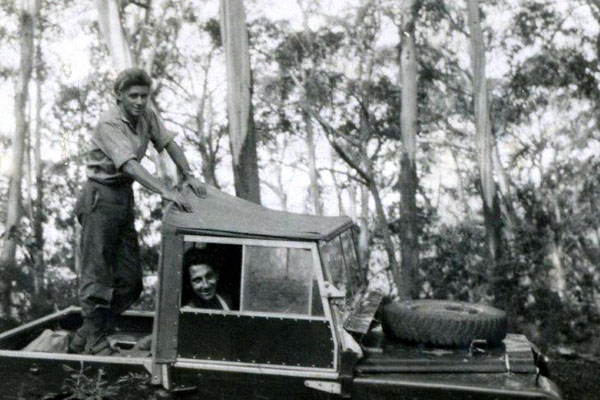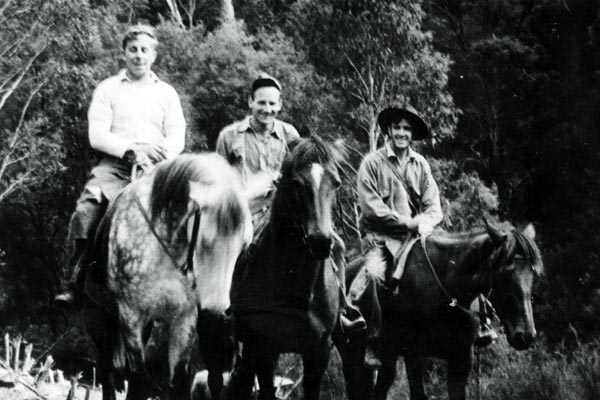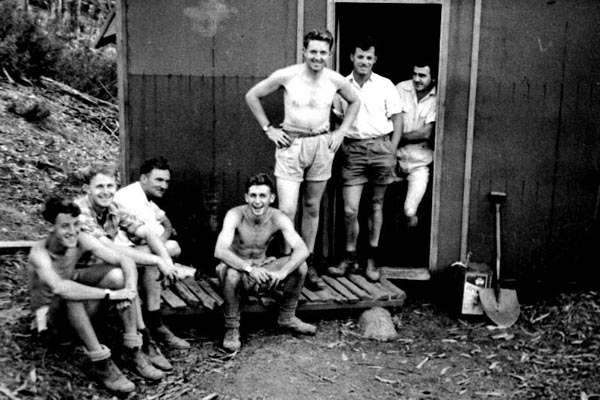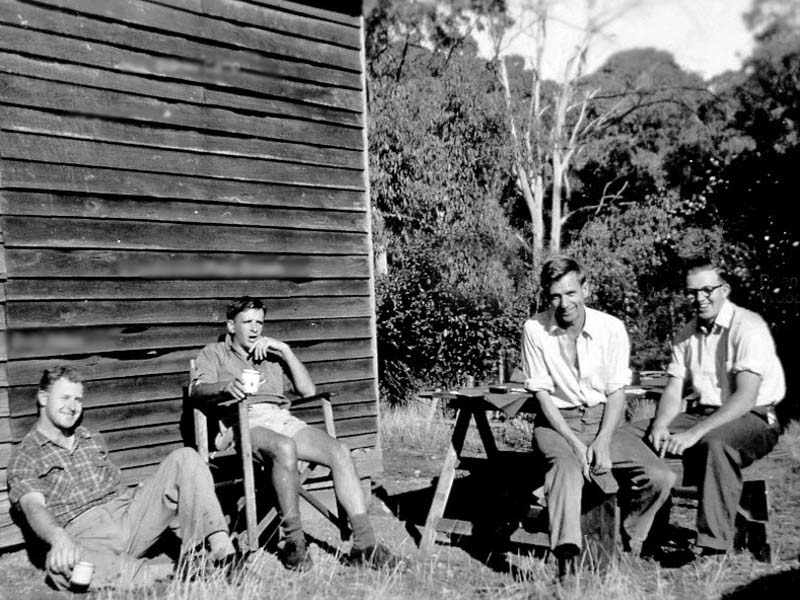Timber assessment in Victoria after WW2 was vitally important in helping to plan supply for the sawmilling industry, and therefore the construction and housing industry. The article by Arthur Webb about his assessment experiences in the early 1950s discusses some of the hardships involved and the nature of the crews that did this work.
When recently browsing through some old FCV correspondence, I came across the following:
Memorandum dated 5 December 1945
Prepared by B. Dahl
Assessment of Big River
Progress Report No 4
“It was necessary to take some men off the assessment parties to assist Fitzpatrick in his work and this left the two assessment parties operating from Snob’s Creek Gap short of men. Later in the month 5 men walked off the job, claiming that the walking was too hard. It is true that the walking is strenuous because no tracks have been adequately cleared, but it also is true that the class of men which has been available has been of a type which in the pre-war years would not have been employed in this type of work. All in all 18 men have left the assessment jobs this year.”
Dahl’s Progress Report No 6 of 4th February 1946 states:
Assessment work progressed through this era to the period described by Arthur (still using pack horses), and then to an era when camps were set up at the end of jeep tracks so that access was by Land Rover. Assessment work in that post-war period was interesting and rewarding for young graduates of the VSF, but of equal importance was the work of Technical staff. (This was true of all field work of the FCV.) These Technical Officers often began as ancillary staff to the crews, but became a very important group who gave continuity of experience and skill as young foresters moved on to other phases of their career.
During the early part of DWM Paine’s time in charge of the Assessment Branch he instituted the Technical Officer positions of Cruiser and Mapper, to give permanency to this group of people who came from a range of backgrounds and work skills. Ray Brash, Bill Hardy, Frank Lloyd, Alan (Sam) Bruton and Ian Edwards occupied these positions. They came from a variety of backgrounds, but adapted to life in the bush camps and to work in settings different to the average everyday job.
Ray Brash grew up in Park Orchards which was quite rural in those days. He worked in local orchards and later in a sawmill in South Australia. He was 18 when he started with the FCV and retired at age 57. He spent quite a few years as a Cruiser and worked on many ‘back country’ assessment jobs, transferring later to the Research Branch as a Technical Officer until his retirement.
Sam Bruton tried his hand at the VSF in 1943 but was not successful, and he joined the Technical Staff of the FCV. He was involved in many ‘back country’ jobs in Gippsland and East Gippsland, being based at Orbost and Bairnsdale. Sam once made the mistake of showing the Forest Assessor some photos taken on the job but forgetting to remove one showing the FCV Land Rover on the top of Mt Kosciusko. He later moved into a Forest Overseer position at Orbost, then Myrtleford and later joined Parks Victoria in south-western Victoria. In 1985 Sam was appointed Assistant Regional Manager (Operations) in the Department of Conservation, Forests and Lands, where he was instrumental in getting the Great South West Walk into operation.
Ian Edwards joined the FCV after service in the Royal Australian Air Force in WW2 as a radio technician. He often reminded people that he had Gerry Griffin (later to become a Commissioner) in his assessment crew at one time. Ian was an exceptional interpreter of aerial photos and a very competent mapper of forest types. He developed an extensive botanical knowledge of native forest plants. He worked in a variety of jobs in East Gippsland and later in pine plantations. Along with Roger Smith, Ian played an important role in an assessment of forest resources in East Gippsland in the early 1970s, when the FCV was pressured to provide forest resource data for the largely unmapped expanses of that region. His photo-interpretation skills were put to the test and yielded the critical data required at that time. Ian could be a hard taskmaster, and was pretty harsh on young foresters who did not cook too well in bush camps. He later lived in Lennox St, Richmond, where he nurtured a collection of Bonsai trees. See also: Forest Mapper
Bill Hardy grew up in an orphanage in South Melbourne, played football in the Carlton Thirds (he often showed his kicking skills at camps in the bush), joined the Army towards the end of WW2 and was posted to the Occupation Forces in Japan at the end of the War. He managed many young foresters in assessment jobs throughout Victoria. Bill was considered to be an extremely adept bush driver. An early assessment project was in the Alpine Ash forests in the vicinity of Mt Useful, north of Heyfield. Bill was involved in setting up Continuous Forest Inventory plots in the Mt Cole Forest, he lead an assessment of the timber on the western fall into the Goolengook River near Mt Ellery in remote East Gippsland, and followed this with a check of an earlier assessment of the Errinundra Plateau.
Frank Lloyd was also an ex-serviceman, having spent time in the Army in Darwin in WW2 where, he often said, “it was as hot as hell” and so saw no cause to complain of assessment camp conditions. In his usual quiet manner Frank was known to comment on the cooking skills, or lack of, in the camp. After tea one night his only comment to a new-chum cook was “it would have been better if you had peeled the carrots”. He was very tolerant of young foresters. Frank was involved in assessment work in the Wombat Forest and in Gippsland, including in the Mt Useful area (north of Heyfield) in the mid-1950s where he decided he would learn to play golf and so constructed a rough nine-hole golf course around the summit of the mount.

Sam Bruton (driving) and Arthur Webb on Nunniong
Summer 1953/54
Source: A Webb

Neil Carr, Ted Naggs and Ray Brash on Mt Skene
1955
Source: B Fry

Assessing at Mt Useful. From left - Jack Gittins, Bob Allen, Frank Lloyd, Arthur Webb, Brian Woodruff, Bill Hardy, Phil King
About 1957
Source: FCRPA

Stanley Camp: l to r - RW Allen, R Brash, I Edwards, BJ Woodruff
About 1958
Source: FCRPA
Little or no topographical mapping was available for the areas in which these men worked. Part of the everyday work routine was therefore to record survey data (usually from chain-and-compass survey techniques), locating gullies and ridge tops and taking barometer pressure readings (from which altitude was calculated) to enable the preparation of basic maps to be used in further forest planning. The major focus in this mapping was to record the boundaries of different forest types, specify the species and to calculate the available quantities of mill logs suitable for supply to sawmills.
These technical officers were a group who handled the harshness of bush camps, the indifferent cooking by a lot of learners and other bush cooks, the frequent moving of camps, living in either canvas tents or prefabricated huts and living in the bush without the finer things of life.